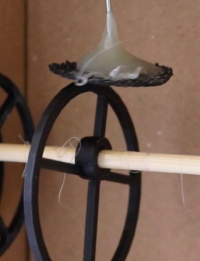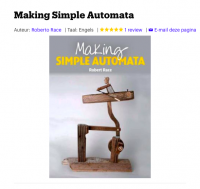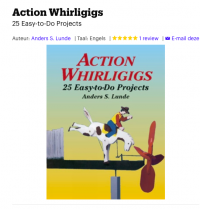Difference between revisions of "Automata"
(→Books) |
|||
| (9 intermediate revisions by one other user not shown) | |||
| Line 1: | Line 1: | ||
Information about automata. | Information about automata. | ||
| + | |||
| + | (All pictures and movies of my own experiments, at the moment only mechanisms!) | ||
Part of a course program for students second year, Animation and Spatial. | Part of a course program for students second year, Animation and Spatial. | ||
| Line 63: | Line 65: | ||
https://www.phoenixstudio.co.uk/courses/automata_with_stephen_guy_june/ | https://www.phoenixstudio.co.uk/courses/automata_with_stephen_guy_june/ | ||
| + | |||
| + | '''Gears and Wheels''' | ||
| + | |||
| + | Making gears is a subpart of the mechanism. | ||
| + | |||
| + | [[File:ab9.png|200px]] Eccentric wheels for pushing | ||
| + | |||
| + | I experimented with making wheels with the 3D printer, eccentric wheels and non circular, oval wheels, meant for pushing movements: https://youtu.be/UPBCXJy8eoY | ||
== Energy sources == | == Energy sources == | ||
| Line 114: | Line 124: | ||
BBQ sticks for axes | BBQ sticks for axes | ||
| − | Glue gun | + | Paper straws for shafts |
| + | |||
| + | '''Tools for low tech''' | ||
| + | |||
| + | These are the "household tools. | ||
| + | |||
| + | *Scissors | ||
| + | *Tape | ||
| + | *Staples | ||
| + | *Glue gun | ||
| + | |||
| + | cutter | ||
| + | |||
| + | '''Low tech materials''' | ||
| − | Paper | + | *Paper |
| + | *Cardboard, using the boxes of the articles I ordered online and also boxes from the supermarket | ||
== Interactivity == | == Interactivity == | ||
| Line 147: | Line 171: | ||
www.arduino.cc | www.arduino.cc | ||
https://microbit.org | https://microbit.org | ||
| + | |||
| + | |||
| + | == Motors == | ||
| + | |||
| + | Yes, the question was, can I show the students how to use servo motors? Of course I can. But a servo motor on itself isn't too much: a servo arm moves 180 degrees and back. So we need some gears and a way to transform this motion. I found on https://www.thingiverse.com the STL files for transferring the motion of a servo motor into linear movement. ( I cannot find the direct link anymore - is it removed?) | ||
| + | |||
| + | {| | ||
| + | |[[File:ab10.png|200px]] | ||
| + | |[[File:ab11.png|200px]] | ||
| + | |[[File:ab12.png|200px]] | ||
| + | |} | ||
| + | |||
| + | In this movie you see the difference between just a servo motor, the linear gear, and a pantograph like contraption of cardboard: https://youtu.be/AOiCokK_qUo | ||
| + | |||
| + | The stepper motor. | ||
| + | |||
| + | This is another motor, which can rotate, the degrees of rotation to be programmed. Also this motor is "nothing" without gears and contraptions. An example: | ||
| + | |||
| + | {| | ||
| + | |[[File:ab20.png|200px]] | ||
| + | |[[File:ab21.png|200px]] | ||
| + | |[[File:ab22.png|200px]] | ||
| + | |[[File:ab23.png|200px]] | ||
| + | |[[File:ab24.png|200px]] | ||
| + | |[[File:ab25.png|200px]] | ||
| + | |} | ||
| + | |||
| + | You can see a movie of the steppermotor, being dressed up: https://youtu.be/vq52m9a3fvc | ||
== Skills == | == Skills == | ||
| Line 164: | Line 216: | ||
and rather important: | and rather important: | ||
| − | Being able to combine all | + | Being able to combine all the different aspects of the automaton! |
| Line 234: | Line 286: | ||
Many more! | Many more! | ||
| + | |||
| + | [[Category:Animation]][[Category:Motors]][[Category:Making]] | ||
Latest revision as of 09:37, 21 November 2022
Information about automata.
(All pictures and movies of my own experiments, at the moment only mechanisms!)
Part of a course program for students second year, Animation and Spatial.
The idea was to add some interactivity (servo motors) to automata.
But an Automaton itself is already complicated beast!
Parts and concepts of Automata:
Storyline
The storyline can be quite simple, some repetitive movement.
- rotation
- going up and down, to and fro, left and right
- combinations, that means combining movements in several different periods
repeating a movement of an object which is plainly visible, for example a helicopter rotating its blades: https://www.youtube.com/watch?v=7W3wgwUfjZA
wishing this movement "opening" something, made something discoverable - surprise - the chicken: https://www.youtube.com/watch?v=ztL5STp_qKg&list=PL9OXNhdKkKnx0Vg2CJHLoZsdhWSHxm_-i&index=2
combination of several movements and several moving figures: a little story: simple example, Chameleon: https://www.youtube.com/watch?v=POjj7yokWXU&t=6s
Figures
Most automata are figurative, that means
Most simple: paper flat figures, a dancer (very simple): https://www.youtube.com/watch?v=4W1dTyUrfZc
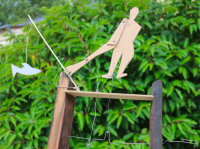 Very simple flat figure with one arm - example for an automaton workshop for children, Poncé-sur-le-Loire, France, 2019.
Very simple flat figure with one arm - example for an automaton workshop for children, Poncé-sur-le-Loire, France, 2019.
3D sculpted figures: wood sculptures: https://www.youtube.com/watch?v=X_5J5J7FdM4
combination of figures:
figures inside a setting, for example a landscape: Sheep: https://www.youtube.com/watch?v=FvfIkG7W5Bg&list=PL9OXNhdKkKnx0Vg2CJHLoZsdhWSHxm_-i
Making figures is "sculpture".
Mechanisms
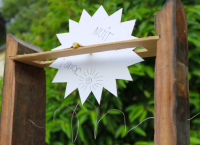 Very crude worm wheel - example for an automaton workshop for children, Poncé-sur-le-Loire, France, 2019.
Very crude worm wheel - example for an automaton workshop for children, Poncé-sur-le-Loire, France, 2019.
The mechanism is part of the fun, and in most of the cases it it open, visible, part of the story.
The mechanisms can be very simple, or very complex.
Indeed if you concentrate on the mechanism you can spend years of study, on cock wheels and different ways to get complicated repetitive movements
The complex does not seem to add to the surprise or the storyline, example: the Archer: https://www.youtube.com/watch?v=afNhgTgvOpA
By studying the mechanism you will discover how many ways there are to generate movements. How many movements there are. How complex movements can be.
Making the mechanism is rather time consuming. Making mechanisms is addictive. It will distract you from the story.
Great stories are made with simple mechanisms. Combining some figures with simple mechanisms will create a story most of the time.
Working for years on the mechanism will probably create something very ingenious but on the storyline rather boring: example: Making a drawing or writing a text: https://www.youtube.com/watch?v=C7oSFNKIlaM
Links for workshops on mechanisms:
https://cabaret.co.uk/store/video/how-to-make-automata/
https://www.phoenixstudio.co.uk/courses/automata_with_stephen_guy_june/
Gears and Wheels
Making gears is a subpart of the mechanism.
I experimented with making wheels with the 3D printer, eccentric wheels and non circular, oval wheels, meant for pushing movements: https://youtu.be/UPBCXJy8eoY
Energy sources
Most automata use the hand, which has to turn a wheel. The question is, when you use other power sources, is it still an automaton?
Since the clock, the watch is one of the first mechanical devices, a spring can be used to drive the automaton.
Water can drive recitative movement, for instance the Shishi Odoshi: https://www.youtube.com/watch?v=lEDGBhb0x8M
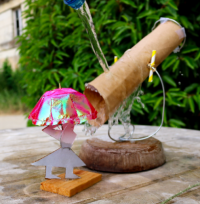 Shishi Odoshi, ししおどし or 鹿威し - example for an automaton workshop for children, Poncé-sur-le-Loire, France, 2019.
Shishi Odoshi, ししおどし or 鹿威し - example for an automaton workshop for children, Poncé-sur-le-Loire, France, 2019.
Waterwheel: https://www.youtube.com/watch?v=cPLX5CUR1G0
The wind: these automatons are called Whirligigs. The Wind drives a propeller, which drives the movement.
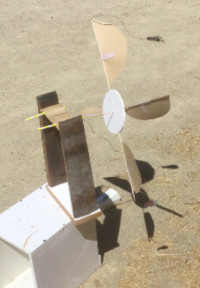 Making a rotating propeller, windmill principle - example for an automaton workshop for children, Poncé-sur-le-Loire, France, 2019.
Making a rotating propeller, windmill principle - example for an automaton workshop for children, Poncé-sur-le-Loire, France, 2019.
In "interactivity" you have a power source, you need that for the microcontroller (unless you use a solar panel), so you have batteries or another electrical power source.
Materials
The most simple is paper. When the figures are made in 3D, then even paper can become stiff. Folding Techniques.
A bit more robust is card board, for slipping gears.
When you have woodworking skills: wood. For cruder gears.
When you have fine metalworking skills: metal. For very fine gears, axis rotating inside shafts.
Plastics, Acrylic: then you can make your gears with the laser cutter.
ABS: when you use the 3D printer, you can make your figures and gears in 3D software, and print it.
Of course combining materials.
Low or High Tech
Making a watch or a clock is really very complicated tech - although it is considered low tech, compared to high tech of electronics, chips, microcontrollers!
I think most fun is making automata from rather low tech materials, becoming very inventive.
When you want to make an automaton from simple materials, you start looking at all materials, waste materials in a creative way, discovering new unexpected uses.
Part of the fun of automata is the surprise, which can ne in the storyline, but also in the inventive materials.
Special parts for low tech
BBQ sticks for axes
Paper straws for shafts
Tools for low tech
These are the "household tools.
- Scissors
- Tape
- Staples
- Glue gun
cutter
Low tech materials
- Paper
- Cardboard, using the boxes of the articles I ordered online and also boxes from the supermarket
Interactivity
Do you still need "interactivity"? Could be.
If you start using a microcontroller, just like mechanisms, you could become addicted to it, the electronics or the programming, and this will then reduce your attention for the storyline.
With microcontroller can add:
- light - LED's for eyes or lighting up an interior of a house.
- sound, music, speech - compare music boxes
- movement by servo or stepper motors - but half of the fun is turning the wheels yourself with a crank
- programming the microcontroller can make the story more "interactive"
- adding sensors, for different behavior when people are around, move, difference in light
- adding buttons, for people to press - different behavior
- adding timers
- adding text displays, for stories
You can add bluetooth, and have an App on your smart phone to give signals to the automaton.
Question: is a robot an automaton? I don't think so - although it could be. A robot doesn't repeat its movement, although it could. A robot is not a (funny) story line. A robot is not a toy - why are automatons toy like?
Links for microcontrollers: www.arduino.cc https://microbit.org
Motors
Yes, the question was, can I show the students how to use servo motors? Of course I can. But a servo motor on itself isn't too much: a servo arm moves 180 degrees and back. So we need some gears and a way to transform this motion. I found on https://www.thingiverse.com the STL files for transferring the motion of a servo motor into linear movement. ( I cannot find the direct link anymore - is it removed?)
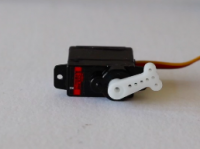
|
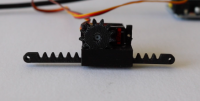
|
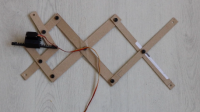
|
In this movie you see the difference between just a servo motor, the linear gear, and a pantograph like contraption of cardboard: https://youtu.be/AOiCokK_qUo
The stepper motor.
This is another motor, which can rotate, the degrees of rotation to be programmed. Also this motor is "nothing" without gears and contraptions. An example:
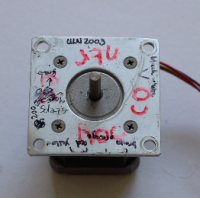
|
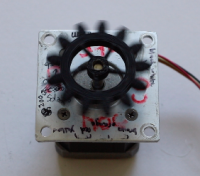
|
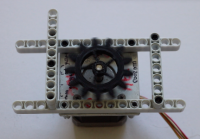
|

|
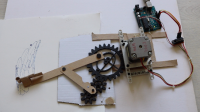
|

|
You can see a movie of the steppermotor, being dressed up: https://youtu.be/vq52m9a3fvc
Skills
To make a funny automaton you need so many skills!
- think of a surprising little story, repeating itself.
- being able to make interesting 3D figures, and backgrounds
- being able to be inventive with different materials
- being able to figure out the mechanism, the gears, the movements
if you want to add interactivity
- being able to do electronics
- being able to program a microcontroller
and rather important:
Being able to combine all the different aspects of the automaton!
Strategy
Start simple. Don't worry about mechanisms, these can be developed. Concentrate on the story. Analyze the movements, the stages in the story. It will be repetitive, how fast is it boring? How can it remain endearing?
Look at a lot of automata, make a choice, search a type within your reach. Look at the possibilities of your material skills, before starting something to far away.
Start experimenting with small ideas in simple materials.
Aha you want "big", "life size" in one go? Adding big motors, with big current? Well then...this will also become a great experience (disasters are fun, aren't they?)
Examples
Youtube has many small movies of Automata.
I prefer the simple, a bit crude examples: https://www.phoenixstudio.co.uk/courses/automata_with_stephen_guy_june/ https://www.youtube.com/watch?v=d_aUyC7dhY0 https://www.youtube.com/watch?v=F4yfmXDctqw
I think the mechanism doesn't have to be too complicated, if you add more figures: ("city principle") https://www.youtube.com/watch?v=bJd6ZLV0_ng https://www.youtube.com/watch?v=ghmbDP3WPs0 https://www.youtube.com/watch?v=lYWlmTVpzlI
Adding a text (maybe activism?) in a crude way: https://www.youtube.com/watch?v=G75D0Hp2iSU
Opening and closing things: "surprise!" https://www.youtube.com/watch?v=5wmyCXAkOi0
The more complicated it gets - this doen't always add to the story, but it will trigger the engineer in you: https://www.youtube.com/watch?v=XM8bbjPWgv0 https://www.youtube.com/watch?v=DfznnKUwywQ https://www.youtube.com/watch?v=oNuhr3htNWs
GEAR STL - free gear making http://joostn.github.io/OpenJsCad/
Be inventive with the material: look at the paper bending https://www.youtube.com/watch?v=cZW5Km1XIwg
Turing machine (complicated!!!) https://www.youtube.com/watch?v=vo8izCKHiF0
Books
Of course these automata make great books. The images are fun, the mechanisms, there is a lot to show and tell!
I bought these ones: (and these can be found in the mediatheek)
These should also be fun:
Many more!
